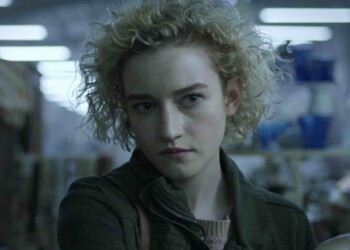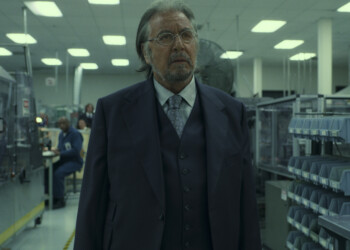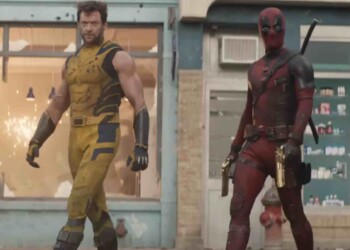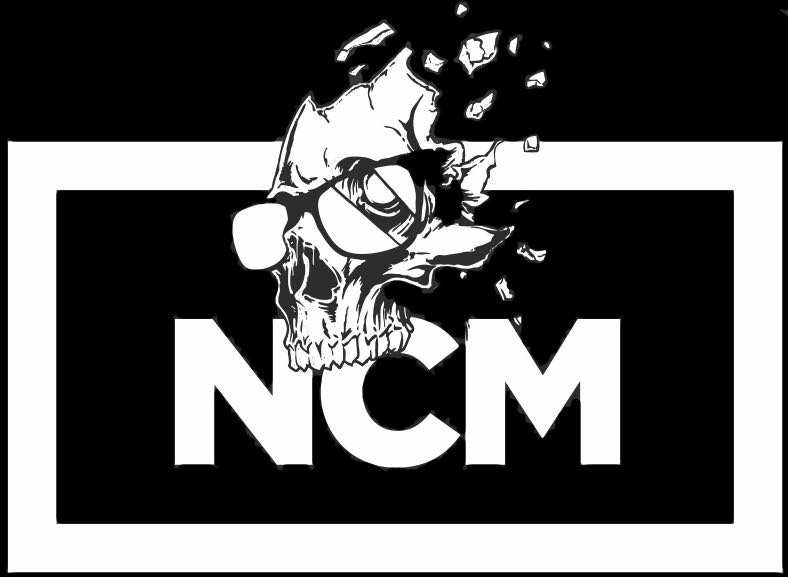The villains of the DC Universe are taking center stage for the next few months as they battle an ultimate evil currently engaged in an effort to conquer the Earth…
By Damon Martin — Editor/Lead Writer
Follow on Twitter @DamonMartin
Major events and storylines are the staple of comic books these days. It started decades ago with multi-issue arcs that then developed into books crossing over into one another, with each event trying to trump the last in terms of shock factor and lasting effect.
As we’ve learned, however, no event is ever permanent so sometimes it feels like both DC and Marvel are really just toying and tinkering with their characters to find the best combination that fits for a certain time period before shifting everything back to the way it was months earlier. Heroes like Superman and Captain America die and within a few issues they are brought back to life. Half of life in the galaxy has been zapped out of existence as well as dead heroes coming back to life and killing their counterparts, but it always goes back to the status quo.
The latest effort in the major event storyline comes to us from DC Comics’ lead writer Geoff Johns in his Forever Evil book that launched on Wednesday. Johns is a master story teller that crafted the Green Lantern into one of the best heroes in the entire comic book world as he peeled back layer after layer of the character while dropping in subtle hints years in advance of a major plot he would reveal later.
Johns’ crowning achievement while working on Green Lantern was the huge crossover event “Blackest Night”, which saw scores of dead heroes brought back to life sent on a mission to kill those still alive, while torturing the ones they loved with the simple message of “why couldn’t you save me?”. It was meticulously woven story that unfolded over the course of several years, and while the end pay off was a bit of a let down, the story as a whole was brilliantly put together. The problem was after Blackest Night ended, Johns then immediately rolled the story into Brightest Day, which was a much sloppier and less interesting story than its predecessor. That rolled into Flashpoint, and then the big bang happened and the New 52 series launched that retconned pretty much everything we knew to that point in the continuity of the story.
So as the New 52 launched with Johns again heading up the company’s biggest books including the new Justice League title putting the comic book giant’s grandest characters together in one storyline, he once again began the pattern of laying down small tracks in the background for the locomotive that would eventually come bearing down on readers as the big payoff years later.
Johns’ began sewing the seeds that would eventually grown and spiral into a crossover event called Trinity War where three different sects of the Justice League would be forced to battle each other over an artifact called Pandora’s Box.
How Did We Get Here?
Just to set the stage for Forever Evil we’ll give a little background about how we got to this point.
First off there was a teaser in the original New 52 book released on Free Comic Book Day that plotted the course of the Trinity of Sin—specifically targeting Pandora, The Question and The Phantom Stranger, but as it turns out that was really a big hoax to what the story would ultimately unfold in the pages of the three Justice League titles just recently.
Pandora (along with the other two) were sentenced to walk the Earth forever and her penance was because she opened the mysterious Pandora’s box, which unleashed evil upon the world. She now walks eternally trying to find the box and a way to contain the evil that was leaked out when it was opened.
Fast forward to the Justice League just recently and we learn that Amanda Waller is organizing a new group called the Justice League of America, formed with each member countering an active hero on the Justice League as a sort of backup system in case the heroes in the Justice League ever get out of hand. They even send Atom (from the Justice League of America) to spy on the real Justice League, pretending to be a full-fledged member.
Pandora shows up while The Justice League is on a mission overseas hoping that Superman—who is just so overwhelmingly good—could open the box and recapture the evil that was let out centuries ago. Unfortunately, Superman can’t withstand the box’s corruptible power and he lashes out and fries a newly minted hero named Doctor Light with his heat vision. Superman quickly turns himself in to be held under lock and key because he believes like everyone else that the box turned him into a murderer and he killed an innocent man.
Meanwhile, there is a shadowy figure lurking in the background quietly putting together a Secret Society of villains, moving chess pieces around the board, and placing everything in the perfect position to eventually bring the Justice League to its knees.
While all three factions of the Justice League (Justice League, Justice League of America and Justice League Dark) all searching for the truth as well as tracking down Pandora’s box again, they all eventually come together and when the box appears a battle ensues between the heroes as they all try to capture it. Think of it as a big battle between caped superheroes where one ring will rule them all (except this time it’s a box).
As it turns out, the box isn’t a mystical object filled with hate, anger, rage and evil—it was actually constructed scientifically on another world to serve as a key that could open a gateway that was left on this Earth years ago as a safe haven if the owners ever needed a portal back. It turns out the shadowy figure is Alfred Pennyworth—from Earth-3—and his mission has been to open the box the entire time to allow his master and his group of co-horts entry into this world where they could take it over and rule with an iron fist. The Trinity of Sin was really just pointing to the No. 3—as in Earth-3.
Superman was never evil or corrupted by Pandora’s box—Atomica (as we find out it’s the Atom from Earth-3) took a sliver of kryptonite and slammed it into a nerve in Superman’s brain causing him to blast Doctor Light with his heat vision and killing him. Atomica leaves the sliver of kryptonite embedded in Superman’s brain knowing that it will literally eat him alive from the inside out while the rest of the heroes believe it was Pandora’s box doing the evil deed to the Man of Steel.
When Alfred opens the portal, in walks the Crime Syndicate of America led by Ultraman—the Earth-3 version of Superman where he’s very bad and he gains his power from absorbing kryptonite instead of being harmed by it. He’s joined by Owlman (Batman from Earth-3), Superwoman (Wonder Woman), Johnny Quick (The Flash), Power Ring (Green Lantern), Deathstorm (Firestorm), Atomica (Atom), Grid (Cyborg), and Sea King (Aquaman, although Sea King dies on his way through the portal).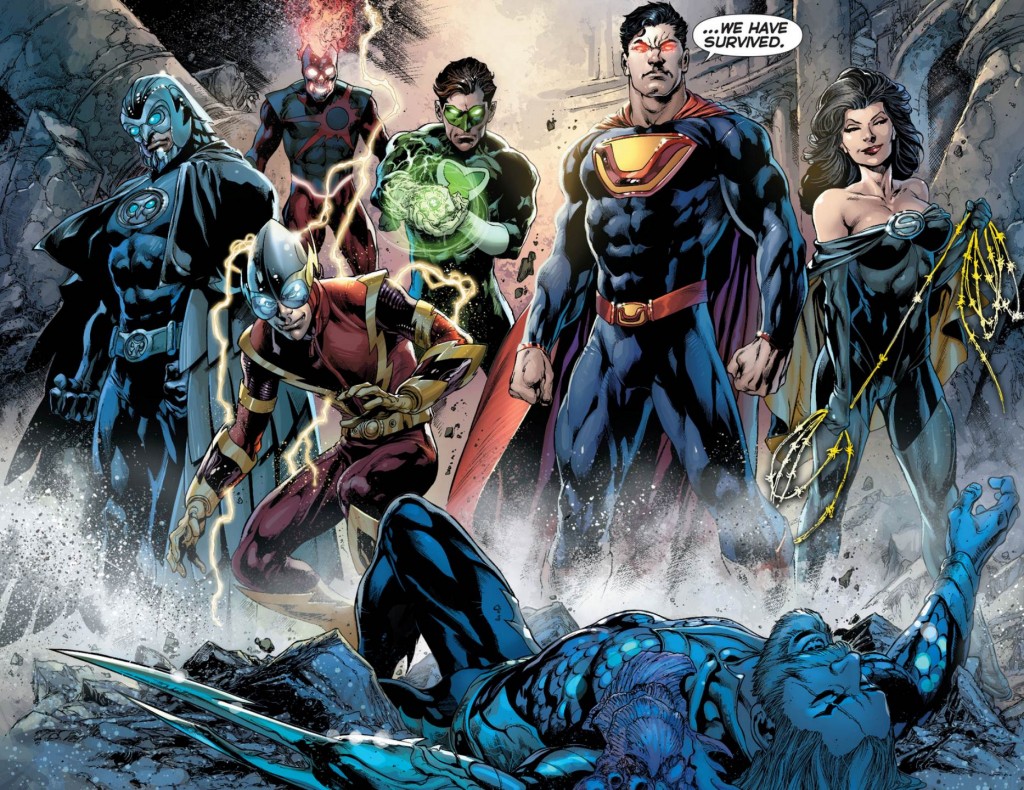
The entire plot was revealed to be a way for Earth-3’s mightiest villains to walk through to this version of Earth and conquer it. Getting the Justice Leagues to battle amongst themselves was the perfect distraction as well as the best way to make them vulnerable enough for the Crime Syndicate to find Pandora’s box, open it, and create the portal to this version of Earth. At the end of Trinity War, the Justice League disappears as the evil-doers from Earth-3 begin their takeover.
In many ways, Trinity War was just a big prequel to what was coming next in Forever Evil, and that really was a cheap tactic by Johns and DC given how much backstory and time was put into developing the entire plot, but then again it was a pretty masterful reveal at the end of it all to bring the Crime Syndicate of America back to the pages of the DC Universe. Certainly some fans might feel ripped off investing two years into this story, believing it to be a mystical force behind Pandora’s Box with the biblical references to the trinity of sin, but the twist and reveal that the artifact was really nothing more than a key to open a door to another world was a fantastic slap of cold water to the face.
Now that will lead us to Forever Evil No. 1, which was released on September 4…
Forever Evil Review
So the stage is set and Forever Evil picks up just days after the encounter between the Justice League factions and the Crime Syndicate of America. The first issue kicks off by showcasing ruthless villain Lex Luthor conducting a business deal, and while the pen may seem mightier than the sword, the bald baddie has no problem yielding both to get what he wants accomplished.
The entire issue is littered with villains from the DC Universe all up to no good—from the Flash’s Rogues Gallery to the laundry list of Batman villains to the maniacal Luthor himself. Johns does a great job writing for all of these characters, even in cameo roles for most of them in the issue, but there is one paramount theme throughout no matter what they are up to—eventually the Justice League will show up to stop them.
It’s then that the Crime Syndicate of America begins to spread its wings, sending out invitations to the villains asking them to join in their new merry band of chaos. They have proof that the Justice League is no more, and they are now in control of this world. The villains can join them and become an army as they take over, or get squashed like a bug if they resist.
The true nature of just how opposite the members of the Crime Syndicate of America from the Justice League is shown in each panel drawn by artist David Finch, and with each word spoken from their mouths courtesy of Johns. This group of psychopaths from another Earth aren’t here to rob banks or make a quick score for some jewelry—no they 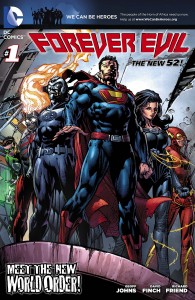 are here to see to the annihilation of any hero that stands against them and create a dictatorship over the entire population of this world.
are here to see to the annihilation of any hero that stands against them and create a dictatorship over the entire population of this world.
The real power in this first issue is Johns’ storytelling when it comes to Lex Luthor.
It’s already been revealed in multiple interviews with Johns leading up to this series that Luthor would in many ways be the central character as Forever Evil unfolds. Since the launch of the New 52, Superman’s arch nemesis hasn’t really had much of a role, so this really is his coming out party during this multi-issue run.
The most powerful scene in the book is when Ultraman kills an innocent bystander as he’s on the hunt for kryptonite to power his body back to full strength. Ultraman’s thirst for power turns him into a junkie, and nothing and nobody will get in his way as he crushes and crystallizes a piece of kryptonite and snorts it up his nose like a vacuum. It’s prolific and powerful imagery there as Finch and Johns combine for one of the best sequences of writing and art that I can remember in a recent comic book.
All of this is witnessed by Luthor, who is laying in the shadows watching this man he believes to be Superman, kill and pillage for his own power. Quickly he realizes this powerful being isn’t Kal-El from Krypton and it’s something much, much worse and far more dangerous—it’s the alien creature with powers beyond anything Earth has ever seen that can take over at a moment’s notice—exactly what Luthor feared from the very day Superman landed on this planet. His worst fears are being realized, except it’s not Superman doing the deed, it’s another version and this one is an even bigger nightmare.
The rest of the first issue (like most first issues in these series) are setting up the story for what comes next. The Justice League are apparently dead (we know they aren’t really) and the Crime Syndicate of America are setting up shop on Earth, ready to take it over, and crush anyone who stands in their way. The villains they’ve recruited will help lead the army into the cities and states they will now rule over, and as an added bonus they decide to capture one particular hero and put him or her through the ringer as an example to anyone who stands in their way.
As a whole, Trinity War was a letdown because it was really just a feeder story to what Johns had planned with Forever Evil. At the same time, similar could be said for any of the books Johns wrote that led to Blackest Night, and as previously referenced that was a fantastic series built in the pages of Green Lantern years earlier.
The first issue of Forever Evil is almost picture perfect in execution from art to story to dialogue at the end of the book. Forever Evil No. 1 gets a perfect 5 out of 5 on the Louis Skolnick scale for the debut issue. Now like every other comic, it’s going to take time to see if the end result is as good as the setup, but so far Forever Evil is paying off big.
What You Need to Know Going Forward
Once you read the first issue of Forever Evil (and you should read it) then you’ll understand the big reveal at the end of the story, as well as who seems to be playing puppet vs. puppeteer.
What we know thus far is…
—The Crime Syndicate of America can control power and communications (through Grid, the robot that took over for Cyborg).
—The heroes of the world are nowhere to be found and the bad guys from Earth-3 are tossing around Superman’s cape and Wonder Woman’s lasso proclaiming that the Justice League is dead.
—Almost all of the villains are currently gathered awaiting word on how entry into this society of evil will benefit them or ultimately tear them down depending on how the crazies from Earth-3 react in this strange, new world.
—And Lex Luthor is out there somewhere, wondering why Superman isn’t stepping into save the world


